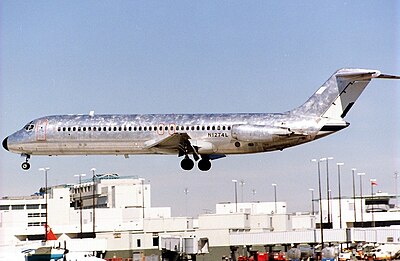
Search
1970 Dominicana de Aviación DC-9 crash

On February 15, 1970, a Dominicana de Aviación McDonnell Douglas DC-9 enroute from Santo Domingo, Dominican Republic to San Juan, Puerto Rico crashed into the Caribbean Sea shortly after takeoff. The crash killed all 102 passengers and crew on board, making it the deadliest aviation disaster to occur in the Dominican Republic until 1996 when Birgenair Flight 301 also crashed into the Caribbean Sea, leaving 189 dead.
Aircraft
The aircraft, a McDonnell Douglas DC-9-32 registered HI177 (with serial number 47500 and line number 546), was built by McDonnell Douglas the previous year, having its maiden flight on September 30, 1969. The aircraft was registered HI177 and delivered to the airline on December 16 the same year. The aircraft was powered by two Pratt & Whitney JT8D-7 turbofan engines. It had been in service with Dominicana for less than a month (with only 354 flying hours) when it crashed.
Accident
The airliner was on an international flight from Las Américas International Airport near Santo Domingo, to San Juan's Luis Muñoz Marín International Airport. The flight took off at about 6:30 PM. Two minutes after departure one of its engines lost power. The crew declared an emergency, telling air traffic controllers that the right engine had flamed out, and requested to immediately return to the airport. While the crew were preparing to turn back toward the airport, the left engine also flamed out. The aircraft descended until it hit the sea about two miles south of the airport. There were no survivors among the 97 passengers and five crew members on board.
Notable victims
Several famous passengers were among the dead, including:
- Former world lightweight boxing champion Carlos Cruz, his wife and their two children.
- The coach and eleven players of Puerto Rico women's national volleyball team, who were returning home after a friendly game against the Dominican Republic women's national volleyball team.
Investigation
There were initially concerns of a terrorist attack as the family of Antonio Imbert Barrera was on board. However, the investigation concluded that the cause of the crash was the sequential failure of both engines caused by fuel pollution due to water ingress. Neither the cockpit voice recorder (CVR) or flight data recorder (FDR) was ever found.
Aftermath
Eight months prior to the accident, on June 23, 1969, in Miami, Florida, an Aviation Traders Carvair, also operating for Dominicana de Aviación as Flight 401, lost control and crashed into buildings, killing all four people on board as well as six people on the ground.
Immediately after the Santo Domingo crash, Dominicana suspended all operations. Four of the airline's mechanics were reportedly arrested as well. In addition, the United States Federal Aviation Administration (FAA) banned Dominicana aircraft from operating to the United States. The ban was lifted later in the year after Dominicana leased a replacement DC-9 aircraft, to be flown by crews from the Spanish airline Iberia.
Dominicana eventually resumed full services, including to the United States. The airline flew until 1995 when the government of Joaquín Balaguer forced it to suspend services indefinitely, officially ceasing all operations in 1999.
See also
- Aviation safety
- List of accidents and incidents involving commercial aircraft
- List of accidents involving sports teams
References
External links
- Fatal McDonnell Douglas DC-9 Events
- Major Aviation Accidents of the Super70s (Archive)
Text submitted to CC-BY-SA license. Source: 1970 Dominicana de Aviación DC-9 crash by Wikipedia (Historical)
Owlapps.net - since 2012 - Les chouettes applications du hibou

